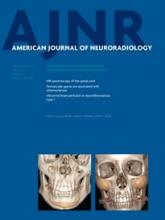Index by author
Zhou, J.
- EDITOR'S CHOICEBrainYou have accessMetabolite Differences in the Lenticular Nucleus in Type 2 Diabetes Mellitus Shown by Proton MR SpectroscopyY. Lin, J. Zhou, L. Sha, Y. Li, X. Qu, L. Liu, H. Chen, Z. An, Y. Wang and C. SunAmerican Journal of Neuroradiology September 2013, 34 (9) 1692-1696; DOI: https://doi.org/10.3174/ajnr.A3492
A group of 22 patients with type 2 diabetes underwent MR spectroscopy of the deep gray matter nuclei and their metabolite ratios of NAA/Cr and Cho/Cr were assessed and correlated with laboratory findings. Metabolite ratios were different in the left and right lenticular nuclei and in the thalami, suggesting that diabetes affects these differently with the former being more vulnerable than the latter. The metabolic abnormalities preceded anatomic lesions.
Zhu, X.J.
- BrainOpen AccessMorphologic Characteristics of Atherosclerotic Middle Cerebral Arteries on 3T High-Resolution MRIX.J. Zhu, B. Du, X. Lou, F.K. Hui, L. Ma, B.W. Zheng, M. Jin, C.X. Wang and W.-J. JiangAmerican Journal of Neuroradiology September 2013, 34 (9) 1717-1722; DOI: https://doi.org/10.3174/ajnr.A3573
Zimmerman, R.A.
- Pediatric NeuroimagingOpen AccessCerebral Diffusion Tensor MR Tractography in Tuberous Sclerosis Complex: Correlation with Neurologic Severity and Tract-Based Spatial Statistical AnalysisA.M. Wong, H.-S. Wang, E.S. Schwartz, C.-H. Toh, R.A. Zimmerman, P.-L. Liu, Y.-M. Wu, S.-H. Ng and J.-J. WangAmerican Journal of Neuroradiology September 2013, 34 (9) 1829-1835; DOI: https://doi.org/10.3174/ajnr.A3507
Zipfel, G.J.
- FELLOWS' JOURNAL CLUBBrainYou have accessHemodynamic Effects of Developmental Venous Anomalies with and without Cavernous MalformationsA. Sharma, G.J. Zipfel, C. Hildebolt and C.P. DerdeynAmerican Journal of Neuroradiology September 2013, 34 (9) 1746-1751; DOI: https://doi.org/10.3174/ajnr.A3516
Perfusion imaging was done in patients with developmental venous anomalies with and without accompanying cavernous malformations. The normal-appearing brain surrounding DVAs showed higher blood volume, longer mean transit time, and variable changes in blood flow. DVAs with cavernomas showed greater MTT prolongation and less blood flow indicating greater restrictive effects upon the adjacent brain. The authors offer some ingenious and interesting explanations for these findings.
Zucca, I.
- Pediatric NeuroimagingYou have accessBilateral Cavitations of Ganglionic Eminence: A Fetal MR Imaging Sign of Halted Brain DevelopmentA. Righini, C. Frassoni, F. Inverardi, C. Parazzini, D. Mei, C. Doneda, T.J. Re, I. Zucca, R. Guerrini, R. Spreafico and F. TriulziAmerican Journal of Neuroradiology September 2013, 34 (9) 1841-1845; DOI: https://doi.org/10.3174/ajnr.A3508








